Patients Value Convenience When Filling Prescriptions, But It’s Up to Providers to Optimize Experiences
In 2022, we conducted a patient survey to learn about the usage of online or other non-traditional pharmacies and how they compare to traditional brick and mortar pharmacies. We found that 96% of adults said technology helped them fill and manage prescription medications.*
We recently ran a new patient survey in order to compare the data and identify any changes to the trends we found two years ago. While a few things stayed the same, including the percentage of participants who say technology has helped them manage prescriptions, there were some notable changes over the years.
This year's data shows that convenience is still the key factor when patients need prescriptions, but usability with apps isn't always smooth. Making good user experience (UX) a priority for patient portals and apps is critical for healthcare providers.
Key findings
Having to leave the house is still the number one drawback of physical pharmacies, with 34% of respondents selecting it as their top issue in 2022 and 40% in 2024.
In 2022, 51% of patients saved up to $50 on prescriptions using online pharmacies. In 2024, 41% say the price is the same regardless of what type of pharmacy they fill their prescriptions with.
In 2022, most patients saved between 6 and 30 minutes of their time using online pharmacies; but in 2024, half of patients save between 11 minutes and an hour.
Convenience of online pharmacies still defines patient preferences
When we looked at the patient preferences around using pharmacies, we found consistency between 2022 and 2024. Specifically, the biggest drawbacks to using physical pharmacies as well as the biggest benefits to using online pharmacies stayed the same for patients over the past two years.
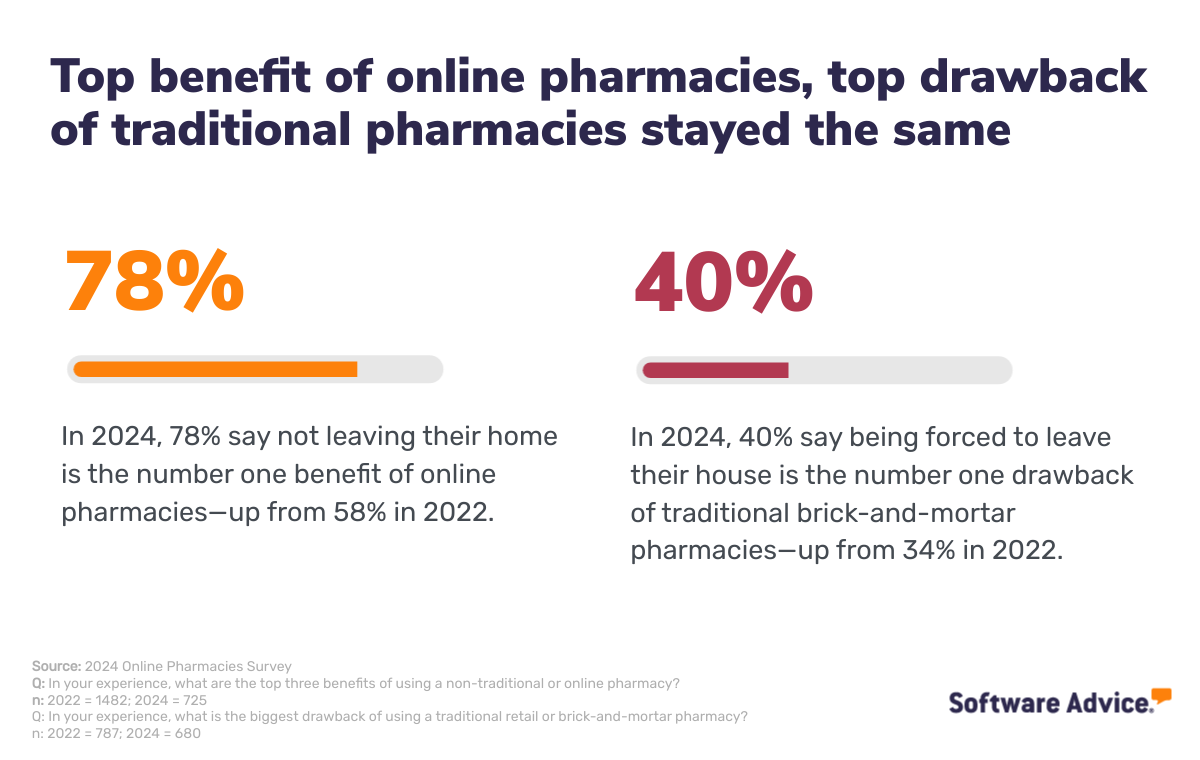
Having to leave the house is still everyone’s least favorite element of using a traditional brick and mortar pharmacy.
On the other hand, the largest benefit of online pharmacies also stayed the same between 2022 and 2024, and it was the exact match to the downside of physical pharmacies: Not having to leave the house.
This tracks with other trends that have cropped up since the onset of COVID in 2020. Mainly, the increased value placed on delivery services that cut down on the number of errands people have to run. This is consistent with a 2023 survey of 1000 homeowners which found that 64% of respondents have a greater desire to be home now than they did before the pandemic. [1]
The bottom line is that people want convenience, and as long as online pharmacies continue to give them that, they’re going to keep being popular.
Patients previously saved more money and enjoyed easier-to-use apps
When comparing our year over year trends, we found two big data points that indicated negative trends in patient experience with online pharmacies.
1. Patients aren’t saving as much money
In 2022, most patients who had long-term prescriptions saved between $1 and $50 when filling those medications at an online pharmacy versus a traditional pharmacy.
However, in 2024, 41% of patients said the price was the same regardless of where they filled their prescription. And of those who did save money, the majority only saved between $1 and $20.
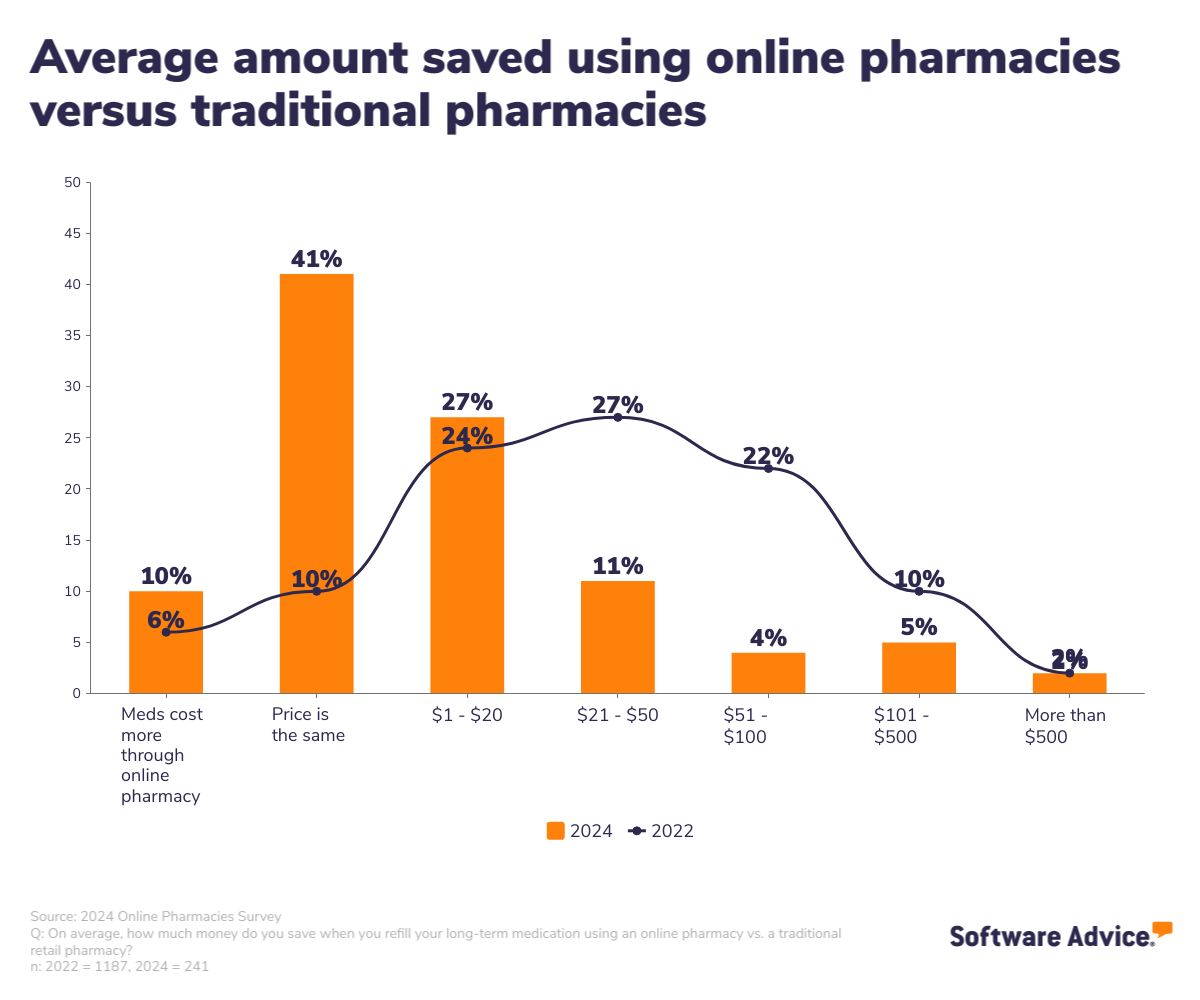
There could be different reasons for this, but the most likely factor is inflation. According to a government report from October 2023, the price of over 4,200 drugs increased between January 2022 and January 2023. Of those increases, 46% were higher than the rate of inflation, and the average drug price increase equaled $590 per drug. [2]
2. Pharmacy apps aren’t as easy to use
Another notable change was that more patients say they’re using pharmacy apps to refill and manage their prescriptions. In fact, while phone calls were the number one method for refilling prescriptions in 2022, mobile apps offered through the pharmacy were the number one method in 2024.
That seems like great news on the surface, but there is a caveat when we look further into this data. We asked patients who said they use these apps to rate their usability.
In 2022, 69% of patients said it was “very” easy to use and 29% said it was “somewhat” easy to use.
In 2024, though, respondents were more split: 46% say the apps are “very” easy to use and 45% say they’re “somewhat” easy to use.
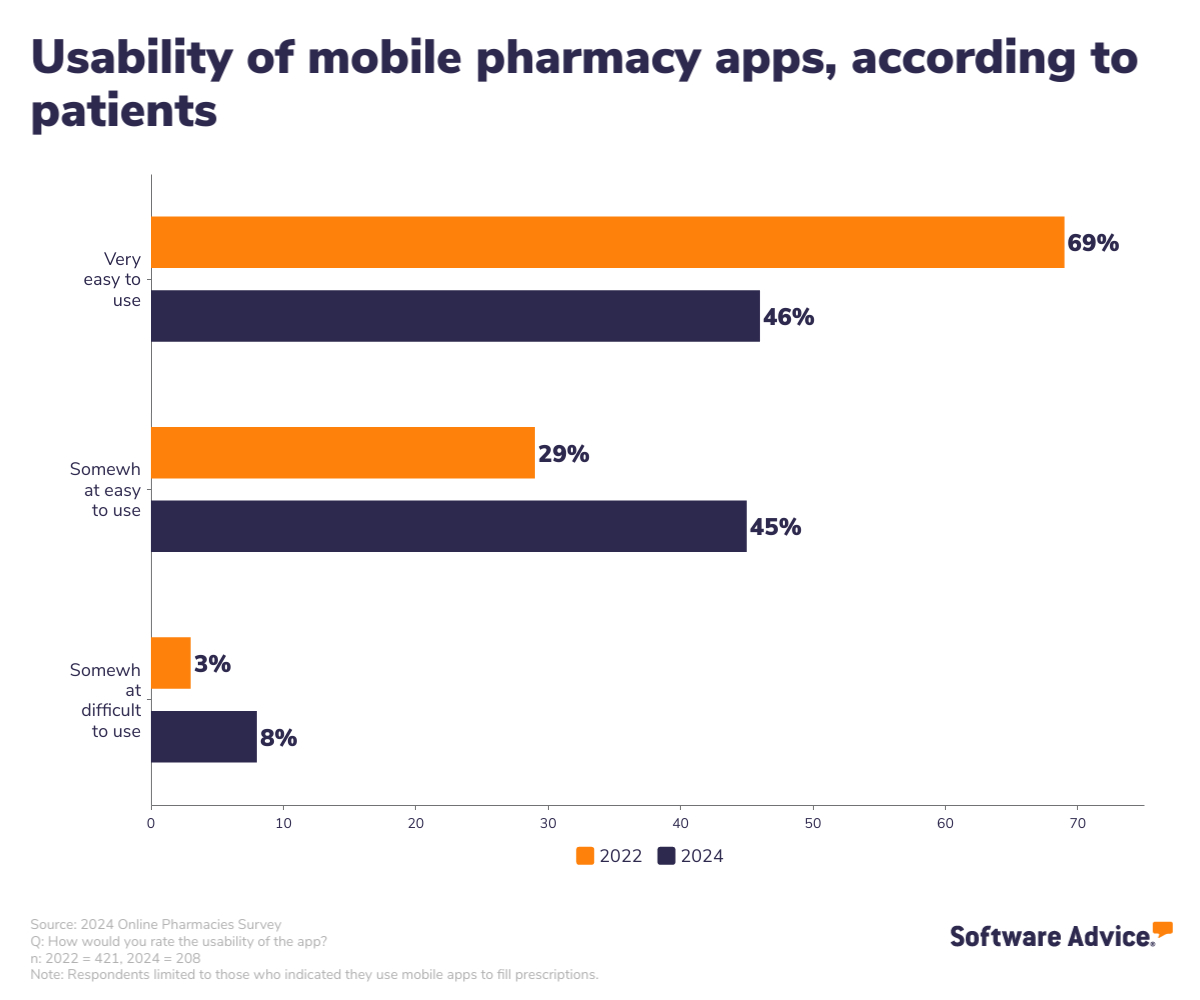
While that’s still largely positive news—only 8% say apps are somewhat difficult to use and 0% say they’re very difficult—it is enough of a shift to cause app developers a bit of stress.
When we break down this stat by age group, we find that the one who had the highest percentage of respondents rating these apps as “somewhat” difficult to use was, surprisingly, Gen Z. Of the 101 respondents who indicated they were born between 1997 and 2012, 15% said the app they used to fill prescriptions was somewhat difficult to use.
That might be surprising at first glance, as many would expect younger generations to be more tech literate and therefore find apps easier to use. However, it’s possible that the younger generations’ immersion in technology has raised their standards to a higher level, and app developers must meet these new expectations in order to satisfy these users.
Patients are saving even more time and enjoying ePrescribing
Now for the good news. Again, we found two trends that indicate a positive development for online pharmacy users over the past two years.
1. People are saving more time
In 2022, a third of patients said they saved 6 - 10 minutes using online pharmacies instead of traditional pharmacies, and 29% saved 11 - 30 minutes. This year, 50% of patients say they save between 11 minutes and an hour of their time using these online pharmacies versus going to a pharmacy in person to collect their prescriptions.
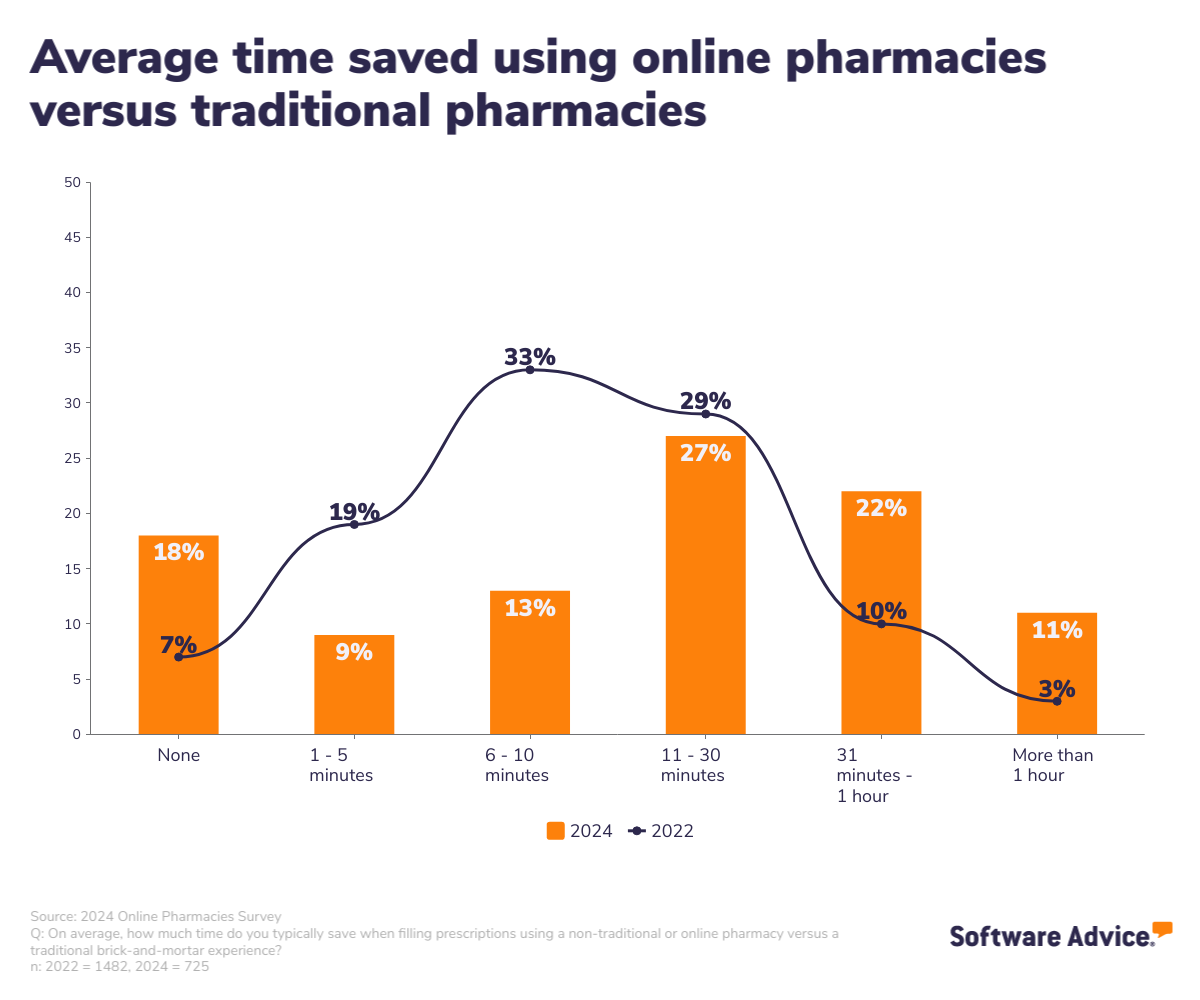
Given the heightened value placed on convenience, this is great news for online pharmacies. It also means that doctors can improve their patients’ experiences by working with these pharmacies more. Many patients conflate the experiences they have at pharmacies with those at doctor’s offices, so ensuring the entire process is as efficient as possible for patients is a smart move.
2. More prescriptions are being sent directly to pharmacies
Another change that was somewhat unexpected is how patients are having their prescriptions sent from their doctors to their pharmacies. In our 2022 survey, 66% of respondents said their doctors asked which pharmacy they preferred and then sent prescriptions directly to that pharmacy. In 2024, that number increased to 93%.
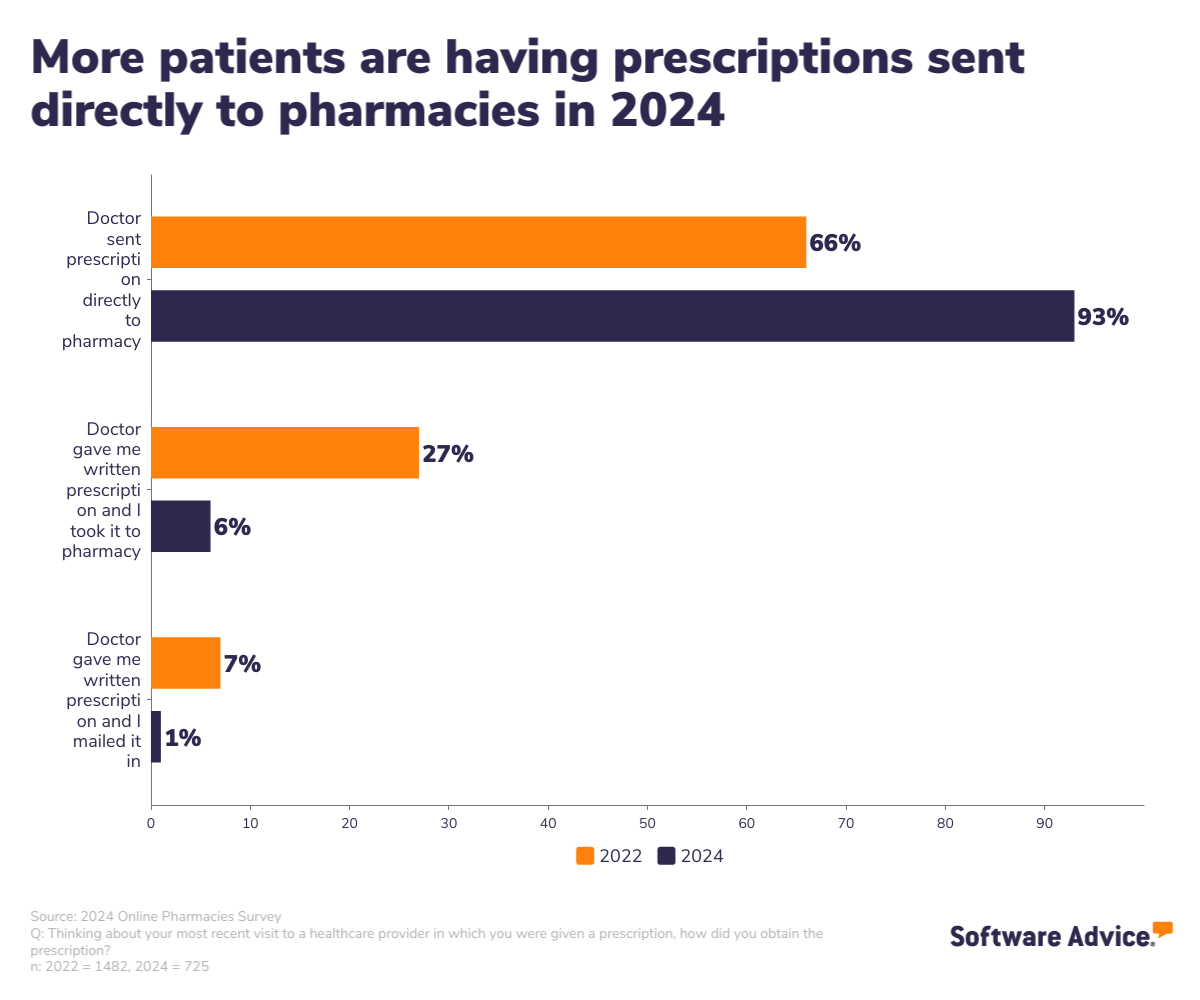
Patients who received written prescriptions and took them to the pharmacy themselves decreased from 27% to 6%—a huge margin.
Again, this is great news. It means more physicians are using ePrescribing software to automate the prescription delivery process, making things even easier for patients. If you aren’t one of them, consider adopting this type of software—or better yet, check if your EHR already offers this functionality as soon as possible.
What does this mean for doctors?
Let’s recap the highlights.
The pros of using online pharmacies and the cons of using in-person pharmacies stayed the same, which tells us that convenience is even more important to patients than it was before the pandemic made delivery services so ubiquitous.
Cost of prescriptions increased, making it less likely for patients to save money using online pharmacies. And while use of pharmacy apps increased, patient satisfaction with these apps actually went down.
And finally, patients are saving even more time by using online pharmacies, which is a huge win for these providers. Likewise, more physicians are using tools like ePrescribing software, which is making patients’ lives easier.
For doctors, this means they must prioritize connecting with online pharmacies in order to give patients the easiest options for filling prescriptions. Doing so will facilitate better medication compliance and make life easier in general for their patients.
Doctors should also go a step further to interface directly with a variety of pharmacies through e-prescribing software. Doing so will increase the convenience factor by making it more likely doctors are already connected with their patients’ preferred pharmacies.
The good news is that a lot of EHRs are already equipped with the ability to e-prescribe and are interoperable with many popular pharmacies, so providers who aren’t already using those features can start right away without having to make any software changes.
Those who don’t have access to online pharmacies, on the other hand, are shorting their patients on convenience and time savings—enough to send any patient looking for a more modern, technologically connected provider who can meet these needs.
Rather than losing patients, take the time to explore interoperable EHR platforms and e-prescribing software to find a solution as soon as possible.
Survey methodology
*Software Advice conducted the 2024 Online Pharmacies Survey in December 2023 through January 2024.
We used screening surveys to narrow respondents down to 725 who have seen a healthcare provider and required a prescription within the past year, as well as those who had used an online pharmacy at least once to fill a prescription.